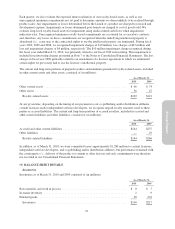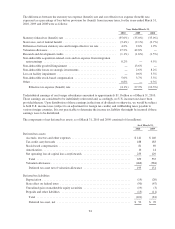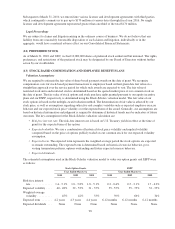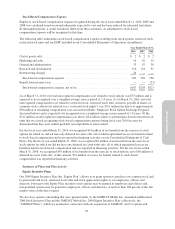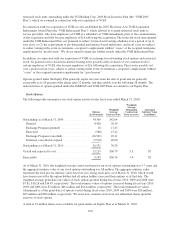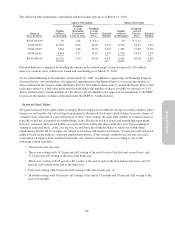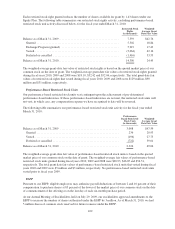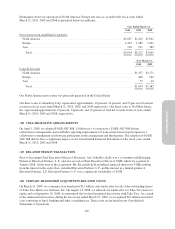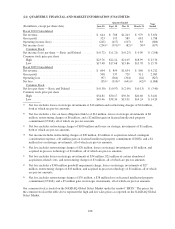Electronic Arts 2010 Annual Report Download - page 177
Download and view the complete annual report
Please find page 177 of the 2010 Electronic Arts annual report below. You can navigate through the pages in the report by either clicking on the pages listed below, or by using the keyword search tool below to find specific information within the annual report.
Annual Report
Stock-Based Compensation Expense
Employee stock-based compensation expense recognized during the fiscal years ended March 31, 2010, 2009 and
2008 was calculated based on awards ultimately expected to vest and has been reduced for estimated forfeitures.
In subsequent periods, if actual forfeitures differ from those estimates, an adjustment to stock-based
compensation expense will be recognized at that time.
The following table summarizes stock-based compensation expense resulting from stock options, restricted stock,
restricted stock units and our ESPP included in our Consolidated Statements of Operations (in millions):
Year Ended March 31,
2010 2009 2008
Cost of goods sold ..........................................................$2$2$2
Marketing and sales ......................................................... 16 20 19
General and administrative ................................................... 33 47 38
Research and development ................................................... 110 134 91
Restructuring charges ....................................................... 26 — —
Stock-based compensation expense .......................................... 187 203 150
Benefit from income taxes ................................................... — — (27)
Stock-based compensation expense, net of tax .................................. $187 $203 $123
As of March 31, 2010, our total unrecognized compensation cost related to stock options was $75 million and is
expected to be recognized over a weighted-average service period of 2.4 years. As of March 31, 2010, our total
unrecognized compensation cost related to restricted stock, restricted stock units and notes payable in shares of
common stock (collectively referred to as “restricted stock rights”) was $311 million (inclusive of approximately
$50 million of remaining compensation cost associated with the “Employee Stock Option Exchange Program”
discussed below) and is expected to be recognized over a weighted-average service period of 1.8 years. Of the
$311 million of unrecognized compensation cost above, $24 million relates to performance-based restricted stock
units that we ceased recognizing stock-based compensation expense during fiscal year 2010 because we
determined that they were neither probable nor improbable of achievement.
For the fiscal year ended March 31, 2010, we recognized $14 million of tax benefit from the exercise of stock
options for which we did not have any deferred tax write-offs; all of which represented excess tax benefit related
to stock-based compensation and was reported in financing activities on our Consolidated Statements of Cash
Flows. For the fiscal year ended March 31, 2009, we recognized $2 million of tax benefit from the exercise of
stock options for which we did not have any deferred tax asset write-offs; all of which represented excess tax
benefit related to stock-based compensation and was reported in financing activities. For the fiscal year ended
March 31, 2008, we recognized $45 million of tax benefit from the exercise of stock options, net of $6 million of
deferred tax asset write-offs; of this amount, $51 million of excess tax benefit related to stock-based
compensation was reported in financing activities.
Summary of Plans and Plan Activity
Equity Incentive Plans
Our 2000 Equity Incentive Plan (the “Equity Plan”) allows us to grant options to purchase our common stock and
to grant restricted stock, restricted stock units and stock appreciation rights to our employees, officers and
directors. Pursuant to the Equity Plan, incentive stock options may be granted to employees and officers and
non-qualified options may be granted to employees, officers and directors, at not less than 100 percent of the fair
market value on the date of grant.
We also have options outstanding that were granted under (1) the JAMDAT Mobile Inc. Amended and Restated
2000 Stock Incentive Plan and the JAMDAT Mobile Inc. 2004 Equity Incentive Plan (collectively, the
“JAMDAT Plans”), which we assumed in connection with our acquisition of JAMDAT, and (2) options and
99




